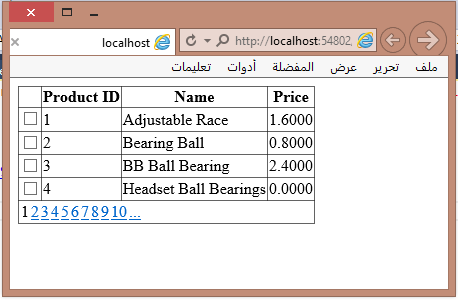ASP.NET
--
Questions
--
Followers
Top Experts
In GridView get cell value when check/uncheck CheckBox control for the same row.
Hi:
How could I get the value of a cell(Product ID) in Gridview , when clicking checkbox control on the same row of the gridview?
Please help.
my web form code here:

How could I get the value of a cell(Product ID) in Gridview , when clicking checkbox control on the same row of the gridview?
Please help.
my web form code here:
<body>
<form id="form1" runat="server">
<div>
<asp:GridView ID="GridView1" runat="server" AllowPaging="True" PageSize="4" AutoGenerateColumns="False"
>
<Columns>
<asp:TemplateField>
<ItemTemplate>
<asp:CheckBox ID="CheckBox1" runat="server" AutoPostBack="True" />
</ItemTemplate>
</asp:TemplateField>
<asp:TemplateField HeaderText="Product ID">
<ItemTemplate>
<asp:Label ID="lblProductID" runat="server" Text='<%# Bind("ProductID") %>'></asp:Label>
</ItemTemplate>
</asp:TemplateField>
<asp:BoundField DataField="Name" HeaderText="Name" />
<asp:BoundField DataField="Price" HeaderText="Price" />
</Columns>
</asp:GridView>
</div>
</form>
</body>public partial class EEquestion2 : System.Web.UI.Page
{
salesDataContext db = new salesDataContext();
protected void Page_Load(object sender, EventArgs e)
{
BindData();
}
private void BindData()
{
var myProducts = db.Products;
if ((myProducts != null) && (myProducts.Count() > 0))
{
GridView1.DataSource = myProducts;
GridView1.DataBind();
}
}
}Zero AI Policy
We believe in human intelligence. Our moderation policy strictly prohibits the use of LLM content in our Q&A threads.
ASKER CERTIFIED SOLUTION
membership
Log in or create a free account to see answer.
Signing up is free and takes 30 seconds. No credit card required.
Please. Where to put this code? In which event.
membership
Log in or create a free account to see answer.
Signing up is free and takes 30 seconds. No credit card required.
Yes I like to have the value when checking the checkbox control in the gridview
Hi Solaiman,
You got the answer or are u facing any problem !!!
You got the answer or are u facing any problem !!!






EARN REWARDS FOR ASKING, ANSWERING, AND MORE.
Earn free swag for participating on the platform.
thank u very much for your help.
ASP.NET
--
Questions
--
Followers
Top Experts
The successor to Active Server Pages, ASP.NET websites utilize the .NET framework to produce dynamic, data and content-driven web applications and services. ASP.NET code can be written using any .NET supported language. As of 2009, ASP.NET can also apply the Model-View-Controller (MVC) pattern to web applications